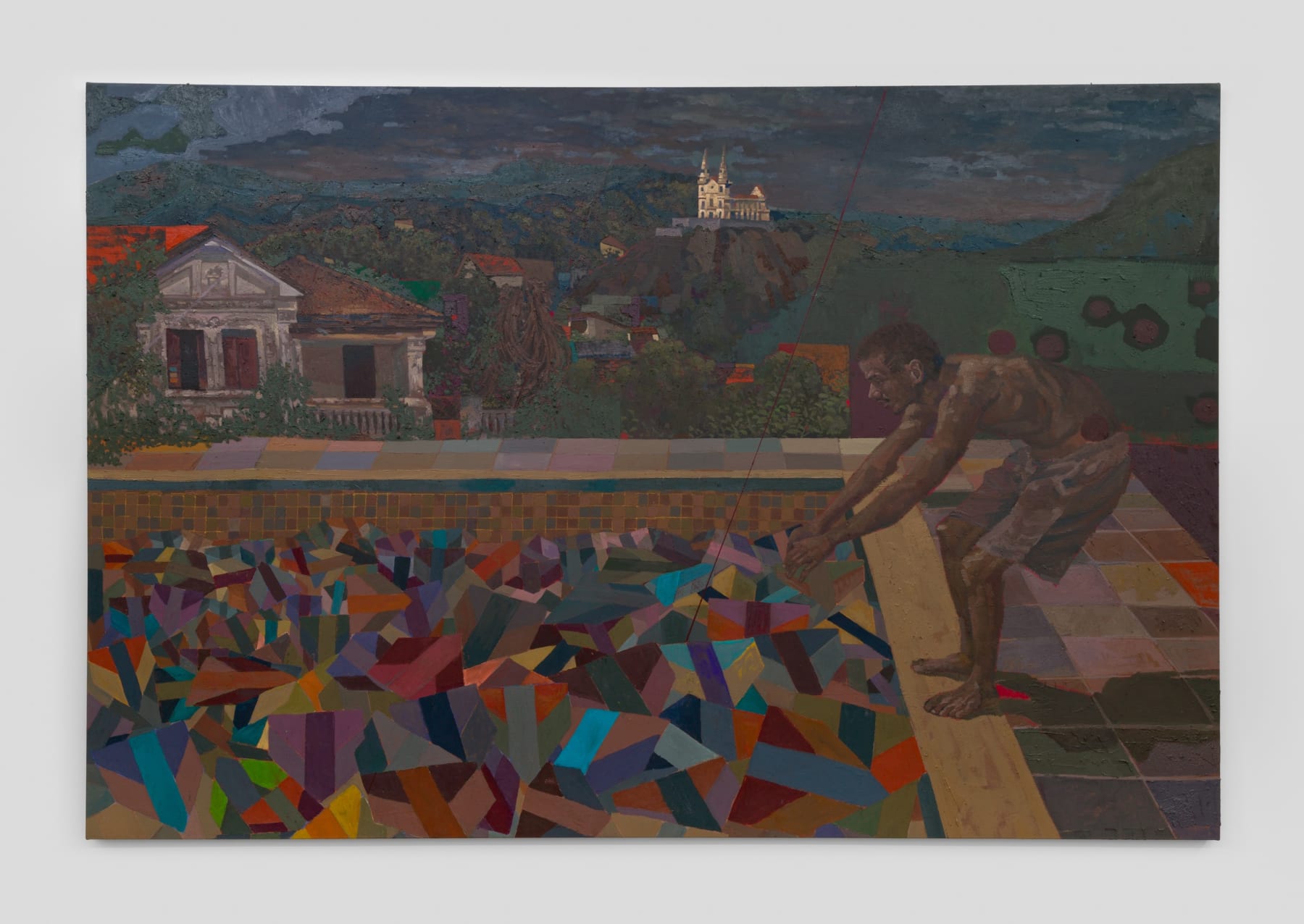Miguel Afa
Dança para o Vento, 2024
óleo e bastão a óleo sobre tela
[oil and oil stick on canvas]
[oil and oil stick on canvas]
200 x 300 x 3 cm
[78 3/4 x 118 1/8 x 1 1/8 in]
[78 3/4 x 118 1/8 x 1 1/8 in]
Copyright O Artista
Mais imagens
A pintura parte de um sonho recorrente do artista: mergulhar em um mar de pipas - símbolo da infância, da liberdade e de uma afetividade próspera. Ao unir referências da...
A pintura parte de um sonho recorrente do artista: mergulhar em um mar de pipas - símbolo da infância, da liberdade e de uma afetividade próspera. Ao unir referências da arte ocidental à paisagem suburbana brasileira, a obra materializa um universo onírico em que o sonho não é fuga, mas permanência. Um homem à beira de uma piscina repleta de pipas coloridas encarna o desejo antigo de uma infância negra e periférica que, nesta pintura encontra espaço para voar.
A obra estabelece um diálogo com "Portrait of an Artist (Pool with Two Figures)", de David Hockney. Ao apropriar-se da composição, Miguel Afa a reinventa dentro de seu próprio repertório visual e geográfico. A cena transcorre no bairro da Penha, zona norte do Rio de Janeiro, onde casas de arquitetura neocolonial compõem o plano intermediário e a Igreja da Penha, imponente ao fundo, oferece eixo espiritual e espacial à composição.
[The painting is based on a recurring dream of the artist: diving into a sea of kites - a symbol of childhood, freedom and prosperous affection. By combining references from Western art with the Brazilian suburban landscape, the artwork materializes a dreamlike universe in which the dream is not an escape, but permanence. A man standing by a pool filled with colorful kites embodies the long-held desire of a black, peripheral childhood that, in this painting, finds space to fly.
The work establishes a dialogue with David Hockney's “Portrait of an Artist (Pool with Two Figures).” By appropriating the composition, Miguel Afa reinvents it within his own visual and geographical repertoire. The scene takes place in the Penha neighborhood, in the northern part of Rio de Janeiro, where neocolonial houses make up the middle ground and the imposing Penha Church in the background provides a spiritual and spatial axis for the composition.]
A obra estabelece um diálogo com "Portrait of an Artist (Pool with Two Figures)", de David Hockney. Ao apropriar-se da composição, Miguel Afa a reinventa dentro de seu próprio repertório visual e geográfico. A cena transcorre no bairro da Penha, zona norte do Rio de Janeiro, onde casas de arquitetura neocolonial compõem o plano intermediário e a Igreja da Penha, imponente ao fundo, oferece eixo espiritual e espacial à composição.
[The painting is based on a recurring dream of the artist: diving into a sea of kites - a symbol of childhood, freedom and prosperous affection. By combining references from Western art with the Brazilian suburban landscape, the artwork materializes a dreamlike universe in which the dream is not an escape, but permanence. A man standing by a pool filled with colorful kites embodies the long-held desire of a black, peripheral childhood that, in this painting, finds space to fly.
The work establishes a dialogue with David Hockney's “Portrait of an Artist (Pool with Two Figures).” By appropriating the composition, Miguel Afa reinvents it within his own visual and geographical repertoire. The scene takes place in the Penha neighborhood, in the northern part of Rio de Janeiro, where neocolonial houses make up the middle ground and the imposing Penha Church in the background provides a spiritual and spatial axis for the composition.]
Na galeria
O vento continua, todavia | Paço Imperial | Rio de Janeiro | Brasil [Brazil] | 14 Jun [Jun] - 10 Ago [Aug] 2025ENTRA PRA DENTRO | A Gentil Carioca | Rio de Janeiro | Brasil [Brazil] | 21 Ago [Aug] - 26 Out [Oct] 2024













